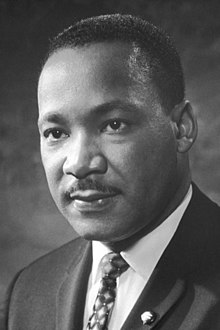 April 4, 1968. Civil rights leader Martin Luther King was killed by a single bullet as he stood on the second floor balcony outside his hotel room in Memphis.1 The shot came from high on his right, not on a horizontal trajectory from the rooming house behind the hotel of the alleged assassin, James Earl Ray. Ray, a mediocre shot, would have needed to stand on the edge of the common bathroom tub to see out the window, and a wall (since conveniently removed) would have kept him from aligning the rifle. Ballistics, forensics, and medical evidence all rule him out. The House Select Committee on Assassinations concluded that there had been a conspiracy, with Ray as the patsy.
April 4, 1968. Civil rights leader Martin Luther King was killed by a single bullet as he stood on the second floor balcony outside his hotel room in Memphis.1 The shot came from high on his right, not on a horizontal trajectory from the rooming house behind the hotel of the alleged assassin, James Earl Ray. Ray, a mediocre shot, would have needed to stand on the edge of the common bathroom tub to see out the window, and a wall (since conveniently removed) would have kept him from aligning the rifle. Ballistics, forensics, and medical evidence all rule him out. The House Select Committee on Assassinations concluded that there had been a conspiracy, with Ray as the patsy.
Critical researchers have argued that the federal government, especially FBI or perhaps CIA, carried out the assassination in order to remove a perceived dangerous critic of racial injustice and the Vietnam War. FBI Director J. Edgar Hoover had publicly denounced MLK, and the Bureau had surveilled and harassed him. CIA also collected intelligence on him, as did military operatives. In contrast, all serious researchers scoff at the notion that Ray was trying to win a $50,000 reward supposedly offered by a racist cabal in St. Louis. The King family specifically exonerated Ray and pointed at the FBI.
Many Reasons to Murder King
There is a much more believable suspect, and several observers2 have suggested it: the KGB.
The KGB had many reasons to murder King.
- To heighten racial antagonism in the U.S.
- To set off riots.
- To remove a moderate African-American leader who did not do the Soviets’ bidding, thereby opening the door to radical leaders.
- To cast suspicion on FBI.
- In keeping with the JFK assassination, to induce the federal government to cover up any conspiracy. The media would predictably fall in line, thereby undermining public trust in the government and media.
- To demoralize Americans and undermine support for democracy.
In sharp contrast to other suspects, the KGB had no disincentives.
In his book on the assassination of King,3 leading researcher Philip Melanson argued that the conspiracy to assassinate King was characteristic not of law enforcement (the FBI) but rather of an intelligence agency. In particular, the remarkable story of Ray’s intricate aliases led him to suspect the CIA or CIA rogues. Although Melanson did not explain why he ruled out the KGB, we can surmise that the misleading messages from hard-to-pin-down government sources in Washington, D.C. to the Memphis police in the run-up to the assassination caused him to suspect U.S. agencies, not the Soviets. These messages distracted the Memphis police and led them to focus on a nonexistent threat to an African-American police detective. But we can see that a KGB asset in FBI or on a congressional staff could readily have originated the messages. Meanwhile, for poorly explained reasons, the MPD pulled patrolling police units away from MLK’s hotel, thus facilitating the escape of the shooter. Agents and informers from FBI and CIA were in Memphis, and the MPD intelligence unit was in close contact with FBI in Washington. Thus there were understandable reasons for Melanson and other researchers to suspect a federal government conspiracy.
So, too, there is a simple explanation of how the KGB could have obtained the security file of Ray’s main alias, Eric S. Galt, a Canadian warehouse supervisor working on Union Carbide research on proximity fuses in Toronto: the KGB had an asset in the Royal Canadian Mounted Police, which maintained a security file on Galt. Melanson assumed that the CIA had obtained access to his file via Union Carbide or the RCMP. But trying to place an asset in, or cultivate assets in, the FBI, CIA, and RCMP was an important part of the KGB’s business. We must assume that sometimes they were successful. This could even happen at a high level. In the 1930s, Congressman Samuel Dickstein, D-NY had been on the KGB payroll.4 Thus much of the evidence Melanson and other researchers found that pointed to CIA actually pointed to the KGB as well, and in a more fitting way in regard to motivation. There were many motives for the KGB to assassinate King, but just a few motives for CIA as well as major disincentives such as flagrantly violating CIA’s mission and risking devastating public exposure.
King had relationships with American communists, and some of his entourage were communist sympathizers. Attorney and entrepreneur Stanley D. Levison served King and the Southern Christian Leadership Conference as a key adviser, writer, and fundraiser. According to a KGB document, Levison was a secret member of the Communist Party of the USA.5 King evidently sought good relations with the Soviets. According to an unnamed retired CIA senior official, the KGB invited King to Toronto where, secretly filmed by the RCMP and CIA, a KGB officer handed King an envelope with a lot of cash in it.6 There is no sign that King followed the Kremlin’s line. While he spoke out against racial injustice and the Vietnam War, he espoused a view that African-Americans should aspire to the freedoms that America offered. Over time, the KGB lost confidence in him and launched a propaganda campaign to undermine him.
Meanwhile, the remarkable story of Ray’s aliases7 better matches the KGB. As a petty criminal, Ray had used many aliases–all of them of family and friends, to make them easy to remember. But after escaping from prison in 1967 and finding his way to Montreal, Ray began to use the name Eric Starvo Galt, later shortened to Eric S. Galt, parallel to how the real Galt had shortened his name. Later he would use the names of three other Canadians. All, including Galt, lived in a single suburb of Toronto. In two cases, Ray used the aliases before he had ever been in Toronto, where he arrived after the assassination. In addition, three of the four men bore some physical resemblance to Ray and to each other. And when Eric S. Galt had surgery to shorten his pointed nose, Ray also had surgery in California to shorten his pointed nose. He used the Galt alias to obtain an Alabama driver’s license and other documentation. The CIA could have in theory arranged all this, if we make the very questionable assumption that CIA carried out the assassination. But it seems odd for CIA to do it in Toronto instead of the U.S. and downright difficult for FBI to do it there since FBI required special permission to operate in Canada. In contrast, it made perfect sense for the KGB to provide these aliases for Ray in Canada, where it faced less surveillance than in the U.S., using its procedures for devising Canadian false identities. Construed correctly, the remarkable aliases of Ray reveal the hand of the KGB.
The KGB’s powerful motives, the demotivators for CIA or FBI, and Ray’s intricate Canadian aliases make it a far more likely organizer of the assassination than CIA or FBI, or than a racist cabal or solo gunman. The many months of readying Ray as patsy would be consistent with the painstaking efforts the KGB made to prepare patsies like Lee Harvey Oswald and Sirhan Sirhan (the KGB also arranged the assassination of Robert F. Kennedy). See The KGB Theory of American Assassinations.
*****
Kenneth J. Dillon is an historian who writes on science and history. See the biosketch at About Us. See also his novel Rosemarie (Washington, D.C.: Scientia Press, 2021).

